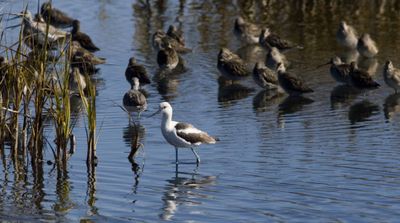Migration has Sound all aflutter
Thousands of birds stop for rest, food

PORT SUSAN BAY, Wash. – All around Puget Sound, fall signals not the end, but the beginning of a new life cycle, as shorebirds just passing through, or arriving to spend the winter, touch down from the far north.
The great fall migration of birds along the Pacific Flyway from northern breeding grounds to southern overwintering areas is under way.
Port Susan Bay and neighboring Skagit Bay are home to the highest concentrations of shorebirds in Puget Sound. It’s a hot spot for the fall shorebird migration and hosts the largest overwintering populations of shorebirds in Puget Sound, with more than 50,000 birds.
Snow geese were a glittering white mirage at Port Susan Bay, as the first of thousands of the showy white birds began arriving from the Arctic just this week to overwinter.
Dunlin sandpipers, also here to stay until spring, were drilling the mudflats with busy bills, and wigeon, those modest waterfowl, were piping soft conversation from the shallows.
Yellowlegs, some passing through on their way south, and some here to stay for the winter, mingled with dowitchers drowsing on one leg, their long bills tucked under their wings as they napped.
Resting up here is crucial to their survival, as they make their journey south to California and South America.
The estuarine habitat of Port Susan, where the saltwater of Puget Sound reaches the delta of the Stillaguamish River, is among the most productive on Earth. The sheer biomass available for these birds to chow down is what draws them and sustains them in their long-haul migrations.
Throughout Puget Sound country, the deltas of the region’s great rivers all used to be home to thousands of shorebirds such as these. But as the deltas were diked and drained, and the shorelines developed, the amount of estuarine habitat has shrunk to about 15 to 20 percent of what used to be available around Puget Sound.
“If they don’t have this, they are in serious trouble,” said Robert Warren, Port Susan Bay project manager for the conservancy. “It’s important not just for shorebirds, but overwintering waterfowl and even salmon.”
Chinook salmon, a threatened species, spend more time in the estuary than other types of salmon, and Port Susan Bay, with a food web wriggling with life, helps juveniles grow fat before heading off to sea. Preserving this place boosts not only the health of the immediate area, but the larger ecology of Puget Sound.
The Nature Conservancy of Washington in 2001 bought 4,122 acres in the bay, nearly all of it tidal wetlands and mudflats, for conservation. Together with another parcel owned by the Whidbey Camano Land Trust, more than 7,000 acres have been set aside in the area for wildlife.
The result is a dreamy span of wind and blowing marsh grasses home to birds in every season. It’s taken years of work to keep it this way, with the conservancy beating back an invasion of spartina, an invasive plant that chokes the mudflats if left unchecked.
The state has been working to eradicate the plant around Puget Sound since the mid-1990s. In Port Susan Bay, the conservancy has used hand application of herbicides to kill it.
Today, the nearshore marshes and expanses of mudflats are mostly clear of the weed, and fully available to wildlife – even an avocet, a leggy wader way out of its usual range east of the mountains but hardly seeming to mind as it mingled with ducks and dowitchers, foraging in the sunny shallows.
It was plainly just too pleasant to leave.
Lucky for us, for throughout Puget Sound, in hundreds of coves and bays large and small, there’s no dead of winter, as shorebirds chase the tide up the mudflats, probing for tiny worms and other intertidal delights.
Theirs is the music of winter.